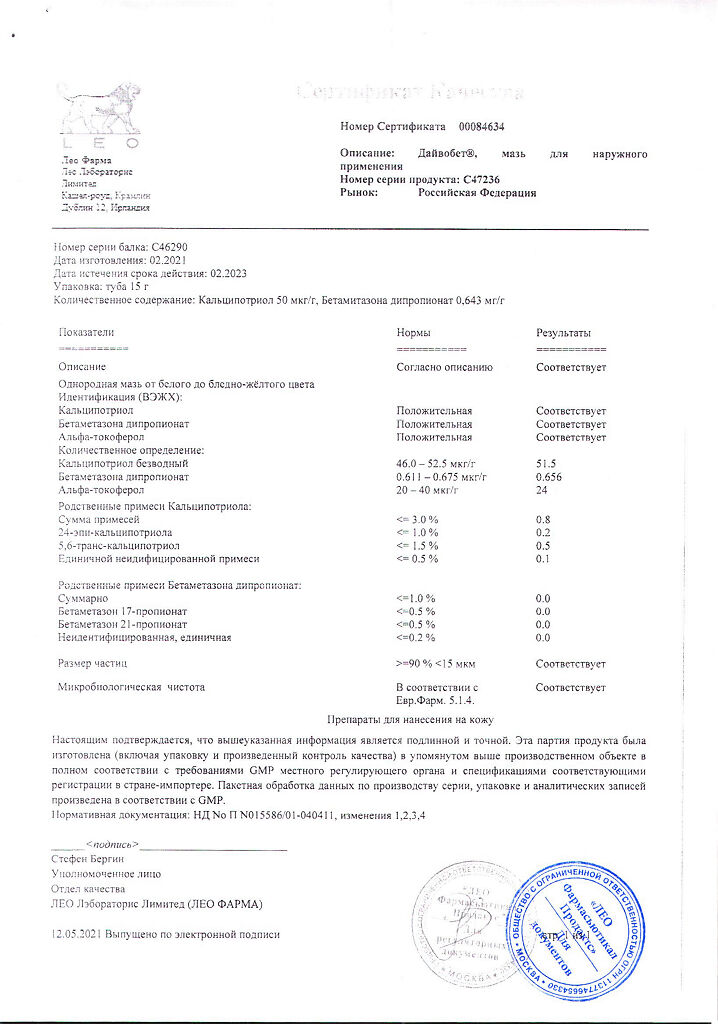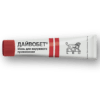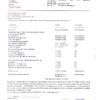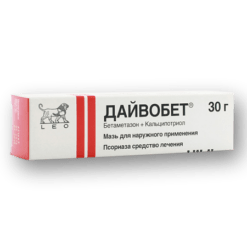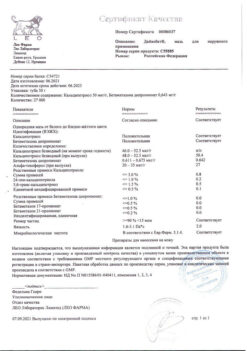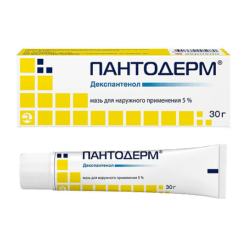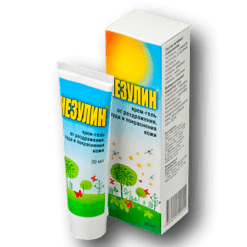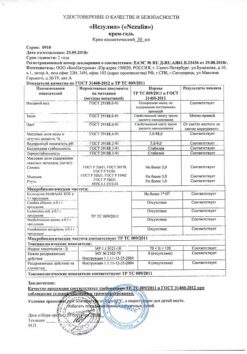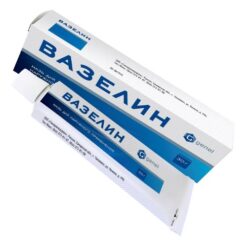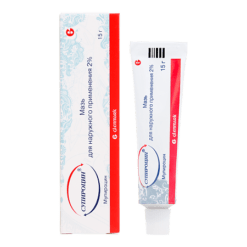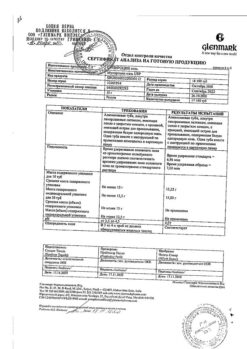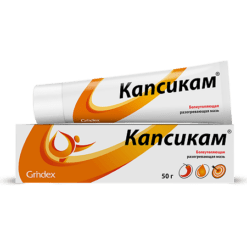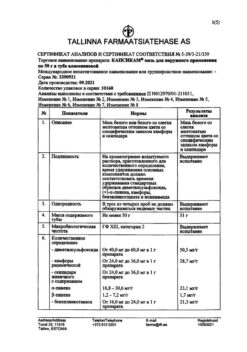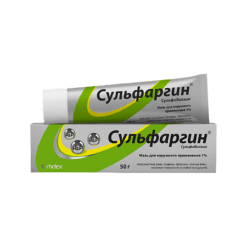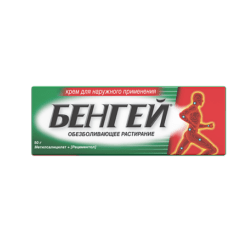No products in the cart.
Daivobet, ointment 15 g
€37.13 €30.94
Description
Pharmacodynamics
Calcipotriol is a synthetic analog of the active metabolite of vitamin D. Causes inhibition of keratinocyte proliferation and accelerates their morphological differentiation.
Betamethasone is a lucocorticosteroid (GCS) for external use. It has local anti-inflammatory, antipruritic, vasoconstrictor and immunosuppressive effects, but the exact mechanisms of anti-inflammatory action of topical GCS are not fully understood. The use of occlusive dressings enhances the effect of topical GKS, as it increases their penetration into the skin proper.
Pharmacokinetics
Absorption and distribution
When using Daivobet, the absorption of calcipotriol and betamethasone through intact skin is less than 1%. When the drug is applied to psoriatic plaques and under occlusive dressings, absorption of the topical GCS is increased. Because a depot of the drug is created in the skin, it is eliminated from the skin within a few days.
Metabolism and excretion
Betamethasone is metabolized in the liver and kidneys to form glucuronides and sulfoesters and is excreted through the intestine and kidneys.
Indications
Indications
Chronic vulgar plaque psoriasis.
Pharmacological effect
Pharmacological effect
Pharmacodynamics
Calcipotriol is a synthetic analogue of the active metabolite of vitamin D. It inhibits the proliferation of keratinocytes and accelerates their morphological differentiation.
Betamethasone is a glucocorticosteroid (GCS) for external use. It has local anti-inflammatory, antipruritic, vasoconstrictor and immunosuppressive effects, but the exact mechanisms of the anti-inflammatory action of topical corticosteroids are not completely clear. The use of occlusive dressings enhances the effect of topical corticosteroids, because at the same time, their penetration into the skin itself increases.
Pharmacokinetics
Suction and distribution
When using Daivobet, the absorption of calcipotriol and betamethasone through intact skin is less than 1%. When applying the drug to psoriatic plaques and under occlusive dressings, the absorption of topical corticosteroids increases. Since a depot of the drug is created in the skin, its elimination from the skin occurs within several days.
Metabolism and excretion
Betamethasone is metabolized in the liver and kidneys to form glucuronides and sulfoesters, and is excreted through the intestines and kidneys.
Special instructions
Special instructions
It is not recommended to apply the ointment to the skin of the face, mucous membranes and scalp. After using the drug, you should wash your hands.
The risk of developing hypercalcemia if the recommended dosage regimen is followed is minimal. However, when Daivobet is used in doses exceeding the recommended maximum weekly dose (100 g), hypercalcemia may develop, which quickly resolves when the dose is reduced or the drug is discontinued.
Daivobet contains a potent corticosteroid, therefore it is not recommended to carry out concomitant treatment with other corticosteroids during its use.
You should avoid using the drug on large areas of skin, constituting more than 30% of the body surface, as well as under an occlusive dressing, apply to skin folds, because this increases the likelihood of systemic absorption of GCS and the development of systemic adverse reactions.
If psoriasis is complicated by a secondary infection, antibacterial therapy should be carried out, and if the infection worsens, discontinue the drug.
During treatment with Daivobet, excessive exposure to natural or artificial sunlight should be limited or avoided. The use of Daivobet in conjunction with UV radiation is only possible if the potential benefit outweighs the potential risk.
Use in pediatrics
There is no clinical experience with the use of Daivobet in children and adolescents under 18 years of age.
Impact on the ability to drive vehicles and other mechanisms that require increased concentration
Daivobet does not affect the ability to drive vehicles or operate machinery.
Active ingredient
Active ingredient
Betamethasone, Calcipotriol
Composition
Composition
1 g of ointment contains:
Pregnancy
Pregnancy
The safety of using Daivobet during pregnancy and lactation has not been established, therefore the use of the drug is possible only when, in the opinion of the doctor, therapy with its use is necessary.
Contraindications
Contraindications
Diseases accompanied by impaired calcium metabolism;
severe renal and liver failure;
viral (including herpes or chickenpox) infections;
fungal skin infections;
bacterial skin infections;
parasitic skin infections;
rosacea;
rosacea;
acne vulgaris;
perioral dermatitis;
skin manifestations of tuberculosis and syphilis;
skin atrophy;
skin ulcers;
increased fragility of skin blood vessels;
ichthyosis;
perianal and genital itching;
psoriatic erythroderma;
guttate, exfoliative, pustular psoriasis;
hypersensitivity to the components of the drug.
Side Effects
Side Effects
Side effects are classified depending on the frequency of occurrence:
most common > 1/10.
frequent >1/100 and <1/10.
uncommon > 1/1000 and < 1/100.
rare > 1/10,000 and < 1/1000.
very rare <1/10,000.
From the skin and skin appendages: frequent – itching, rash, burning sensation; uncommon – pain, irritation, dermatitis, erythema, exacerbation of psoriasis, pigmentation disorder at the site of ointment application, folliculitis; rare – pustular psoriasis.
Calcipotriol can cause local skin irritation, itching, burning, acute pain, dry skin, erythema, rash, dermatitis, eczema and exacerbation of psoriasis. Long-term topical use of betamethasone (dipropionate) is associated with the development of skin atrophy, telangiectasia, striae, folliculitis, hypertrichosis, perioral dermatitis, allergic contact dermatitis, depigmentation, colloid degeneration of the skin, as well as an increased risk of developing generalized pustular psoriasis, hyper- and photosensitivity reactions, including extremely rare cases of angioedema swelling and swelling of the face.
Systemic reactions: A very rare side effect with the use of calcipotriol is hypercalcemia or hypercalciuria. Associated with topical use of betamethasone (rare, but sometimes severe, especially with long-term use, on large surfaces and when using occlusive dressings): suppression of adrenal function, cataracts, infections, increased intraocular pressure.
Side effects, such as suppression of the hypothalamic-pituitary-adrenal axis with the development of reversible secondary adrenal insufficiency or exacerbation of diabetes mellitus associated with the systemic administration of GCS, can also be observed with long-term use of topical GCS due to systemic absorption.
Interaction
Interaction
To date, drug interactions with Daivobet have not been described.
Overdose
Overdose
Symptoms: increased calcium levels in the blood, suppression of the function of the pituitary-adrenal system with the development of reversible secondary adrenal insufficiency.
Treatment: drug withdrawal; If necessary, carry out symptomatic therapy. In cases of chronic toxicity, GCS should be discontinued gradually.
Storage conditions
Storage conditions
At a temperature not exceeding 25 °C
Shelf life
Shelf life
2 years
Manufacturer
Manufacturer
LEO Laboratories Limited, Ireland
Additional information
| Shelf life | 2 years |
|---|---|
| Conditions of storage | At a temperature not exceeding 25 °C |
| Manufacturer | LEO Laboratories Limited, Ireland |
| Medication form | topical ointment |
| Brand | LEO Laboratories Limited |
Other forms…
Related products
Buy Daivobet, ointment 15 g with delivery to USA, UK, Europe and over 120 other countries.


